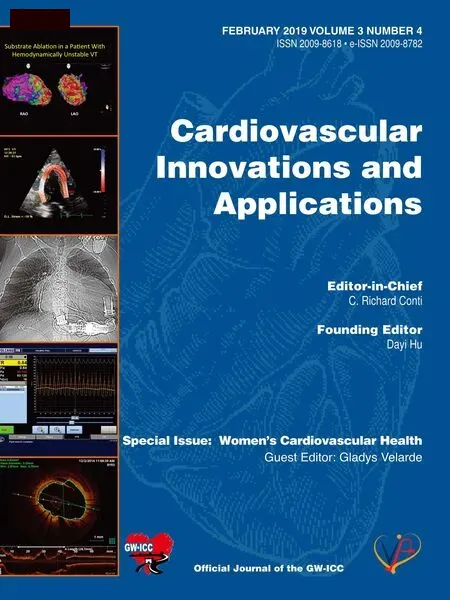Guidelines
C. Richard Conti, MD, MACC
Definition of Guidelines
I would like to start out this editorial by reviewing for the reader my view of what guidelines are. I like the def nition put forth by the Institute of Medicine(IOM). They def ne guidelines as “systematically developed statements to assist practitioner and patient decisions about appropriate healthcare for a specif c clinical circumstance”. I think the operative words in this statement is to “assist the practitioner and patient”. Therefore guidelines are there to aid with clinical decision making and as far as I know are not mandatory or enforced.
Guidelines change
Guidelines are not static and are rather f uid. For example, guidelines written 10 years ago may not necessarily apply to the same condition in 2017. If there are changes, the guidelines should be upgraded based on new and conf rmed clinical information.
Guideline Similarity and Differences
Often there are differences in guidelines generated from the European Society of Cardiology, Canadian Cardiovascular Society and the ACC/AHA.Admittedly, the differences are small but there are differences despite the fact that guidelines are generated by a group of individuals who generally have the same amount of clinical information and level of expertise in all three societies. Are these differences related to the EGO’s of the societies?
Do Guidelines apply to all patients?
Guidelines may not necessarily apply to all patients given the same cardiovascular condition. Thus judgement is still necessary since decision making in an individual patient is not one based on 1,000 or 10,000 patients as it is in clinical trials but on an“N” of one.
Guideline Writing Committees
What follows are recommendations from most
guideline writing committees related to the class of recommendation (COR) and the level of evidence(LOE) for the recommendation.
Class of Recommendations (COR) [1]
Class 1 COR
A class one recommendation is a strong recommendation in favor of the procedure or diagnostic study and benef ts are far greater than the risks.
Class 2A COR
Class 2A recommendations indicate that the benef t is greater than the risk and the procedure and/or diagnostic study is reasonable and useful.
Class 2B COR
Class 2B recommendation indicates that the benef t is slightly greater than the risk and the procedure may or might be reasonable and may or might be considered but the usefulness/ef fectiveness etc. is not well established.
Class 3 COR
Class 3 recommendation is moderate if the benef ts equal the risk. Although the procedure is not recommended or indicated and probably should not be performed. When the risk is greater than the benef t,procedures are considered potentially harmful, and may be associated with excess mortality and morbidity. It is strongly recommended that the procedure should not be performed.
What Guidelines are Acceptable?
It seems to me that all guidelines except guideline with the COR of 3 are acceptable recommendations.Some more than others.
Level of Evidence (LOE)
Level A
Level A indicates that the evidence is high quality from more than one randomized controlled trial or a meta-analysis of high quality randomized controlled trials or the combination of a high quality randomized controlled trial and high quality registries data.
Level B
Level B (randomized), this level of evidence comes from moderate quality evidence from one or more randomized controlled trials or meta-analyses of a moderate quality randomized controlled trial.
Level B (non-randomized), this level of evidence comes from moderate quality evidence from one or more well-designed well-executed non-randomized studies observational studies or registry studies.
Level C
Level C can also be divided into two groups one with limited data and the other related to expert opinion:
-Expert opinion LOE C Limited Data, derived from randomized or non-randomized observational registry studies with limitations of design or execution, Meta-analyses of such studies, and physiologic or mechanistic studies in human subjects.
-Expert Opinion LOE C is a consensus based on clinical experience. The latter recommendation does not imply that the recommendation is weak since many important clinical questions addressed in guidelines do not lend themselves to clinical trials but there may be a clear consensus that a particular test or therapy is useful or effective.
Relationship of LOE to Patient’s Desires
None of the class of recommendations (COR) or level of evidence (LOE) makes any statement about patient’s wishes to have or not to have the recommended procedure.
It seems to me that all except class of recommendations 3 are acceptable; patient preference may inf uence decision making by the practitioner.
Remember; guidelines recommendations are based on results of population research with a large“N”. When a physician is faced with a single patient the “N” is one [2]. Thus the guidelines can be used to help make judgements. Judgement is still a major requirement when taking care of one patient at a time.
 Cardiovascular Innovations and Applications2018年4期
Cardiovascular Innovations and Applications2018年4期
- Cardiovascular Innovations and Applications的其它文章
- AED, LifeVest Defibrillator or Hybrid Approach
- Palliative and/or Hospice Care for Elderly Patients being Considered for Device Therapy
- Institutional Memory
- Circadian Misalignment and Cardiovascular Risk
- Special Edition Women’ s Cardiovascular Health
- Cardiovascular Innovations and Applications
